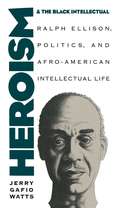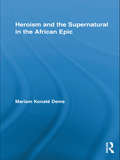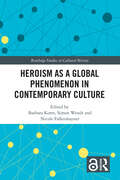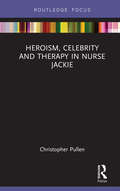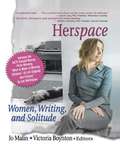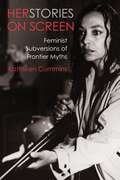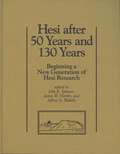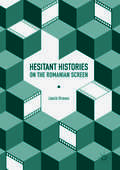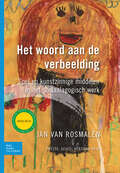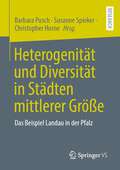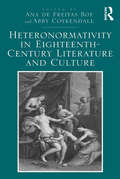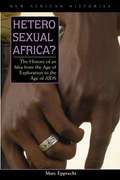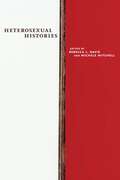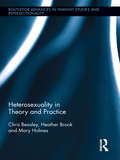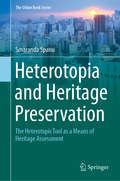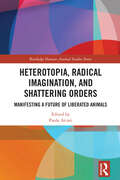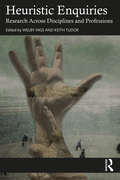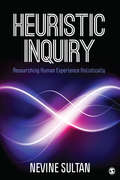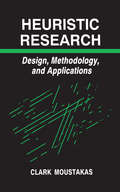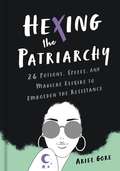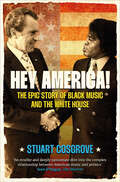- Table View
- List View
Heroism and the Black Intellectual
by Jerry Gafio WattsBefore and after writing Invisible Man, novelist and essayist Ralph Ellison fought to secure a place as a black intellectual in a white-dominated society. In this sophisticated analysis of Ellison's cultural politics, Jerry Watts examines the ways in which black artists and thinkers attempt to establish creative intellectual spaces for themselves. Using Ellison as a case study, Watts makes important observations about the role of black intellectuals in America today. Watts argues that black intellectuals have had to navigate their way through a society that both denied them the resources, status, and encouragement available to their white peers and alienated them from the rest of their ethnic group. For Ellison to pursue meaningful intellectual activities in the face of this marginalization demanded creative heroism, a new social and artistic stance that challenges cultural stereotypes. For example, Ellison first created an artistic space for himself by associating with Communist party literary circles, which recognized the value of his writing long before the rest of society was open to his work. In addition, to avoid prescriptive white intellectual norms, Ellison developed his own ideology, which Watts terms the 'blues aesthetic.' Watts's ambitious study reveals a side of Ellison rarely acknowledged, blending careful criticism of art with a wholesale engagement with society.
Heroism and the Supernatural in the African Epic (African Studies)
by Mariam Konaté DemeThere exists a strong tendency within Western literary criticism to either deny the existence of epics in Africa or to see African literatures as exotic copies of European originals. In both cases, Western criticism has largely failed to acknowledge the distinctiveness of African literary aesthetics. This book revises traditional literary canons in examining the social, cultural and emotional specificity of African epics. Mariam Konate Deme highlights the distinguishing features that characterize the African epic, emphasizing the significance of the fantastic and its use as an essential element in the dramatic structure of African epics. As Deme notes, the fantastic can be fully appreciated only against the cosmological background of the societies that produce those heroic tales. This book not only contributes to the scholarship on African oral literature, but also adds reshapes our understanding of heroic literature in general.
Heroism as a Global Phenomenon in Contemporary Culture (Routledge Studies in Cultural History #71)
by Simon Wendt Nicole Falkenhayner Barbara KorteHeroes and heroic discourse have gained new visibility in the twenty-first century. This is noted in recent research on the heroic, but it has been largely ignored that heroism is increasingly a global phenomenon both in terms of production and consumption. This edited collection aims to bridge this research void and brings together case studies by scholars from different parts of the world and diverse fields. They explore how transnational and transcultural processes of translation and adaptation shape notions of the heroic in non-Western and Western cultures alike. The book provides fresh perspectives on heroism studies and offers a new angle for global and postcolonial studies.
Heroism, Celebrity and Therapy in Nurse Jackie (Routledge Focus on Television Studies)
by Christopher PullenThis book presents an examination of the television series Nurse Jackie, making connections between the representational processes and the audience consumption of the series. A key point of reference is the political and performative potential of Nurse Jackie with regards to its progressive representation of prescription drug addiction and its relationship to the concept of quality television. It deconstructs Nurse Jackie ’s discursive potential, involving intersections with contemporary notions of genre, heroism, celebrity, therapy and feminism. At the same time this book foregrounds the self-refl exive educational potential of the series, largely enabled by the scriptwriters and the leading actor Edie Falco.
Hers: Through Women's Eyes
by Nancy NewhouseThis collection includes essays from the "Hers" column of The New York Times, edited by Nancy Newhouse.
Herspace: Women, Writing, and Solitude
by J Dianne Garner Victoria Boynton Jo MalinThis collection delves deeply into the power of solitude in a richly detailed exploration of the lives of women writers! The essays in this fascinating volume combine literary theory, autobiography, performance, and criticism, while opening minds and expanding concepts of women's roles both in the home and within academia along the way. Herspace: Women, Writing, and Solitude begins with a discussion of the importance of solitude to the works of a variety of writers, including Margaret Atwood, May Sarton, Virginia Woolf, Marguerite Duras, and Zora Neale Hurston, and then moves on to an examination of the actual solitary spaces of women writers. The book concludes with the stories of modern women asserting their right to a space of their own. These essays, full of pain and new growth, lessons learned and battles fought, resound with the honesty and courage the authors have found in the process of truly making their own homes. Herspace examines: the stereotyped spinster solitude as a process and a journey women's prison literature cars, empty nests, kitchen counters, and other found spaces for writing the meaning of a home of one's own creating beauty in solitary settings Contributors to Herspace have made a conscious effort to integrate the personal with the academic, and the result is a volume of surprising intimacy, a window into the world of women writers past and present actively engaging solitude. From finding and defining the muse to the identity issues of home ownership, Herspace, which includes Jan Wellington's essay "What to Make of Missing Children (A Life Slipping into Fiction)," (winner of the 2003 NCTE Donald Murray Prize for "the best creative essay about teaching and/or writing published during the preceding year") provides you with the perspectives of women who are living these issues. As the editors write: "The solitary space itself enables the writing process, protects it. And women, more than men, need this enabling protection. Women need to claim their own space, to bargain and plan and keep out of sight that solitary space in which to commune with their thoughts and feelings, to experience their creative process intimately." Herspace explores these women's experiences, revealing the unique creativity that comes from solitude.
Herstories on Screen: Feminist Subversions of Frontier Myths
by Professor Kathleen CumminsFrom the late 1970s into the early 1990s, a generation of female filmmakers took aim at their home countries’ popular myths of the frontier. Deeply influenced by second-wave feminism and supported by hard-won access to governmental and institutional funding and training, their trailblazing films challenged traditionally male genres like the Western. Instead of reinforcing the myths of nationhood often portrayed in such films—invariably featuring a lone white male hero pitted against the “savage” and “uncivilized” native terrain—these filmmakers constructed counternarratives centering on women and marginalized communities. In place of rugged cowboys violently removing indigenous peoples to make the frontier safe for their virtuous wives and daughters, these filmmakers told the stories of colonial and postcolonial societies from a female and/or subaltern point of view.Herstories on Screen is a transnational study of feature narrative films from Australia, Canada, the United States, and New Zealand/Aotearoa that deconstruct settler-colonial myths. Kathleen Cummins offers in-depth readings of ten works by a diverse range of women filmmakers including Jane Campion, Julie Dash, Merata Mita, Tracey Moffatt, and Anne Wheeler. She reveals how they skillfully deploy genre tropes and popular storytelling conventions in order to critique master narratives of feminine domesticity and purity and depict women and subaltern people performing acts of agency and resistance. Cummins details the ways in which second-wave feminist theory and aesthetics informed these filmmakers’ efforts to debunk idealized Anglo-Saxon femininity and motherhood and lay bare gendered and sexual violence and colonial oppression.
Hesi after 50 Years and 130 Years: Beginning a New Generation of Hesi Research (Joint Archaeological Expedition to Tell el-Hesi)
by John R. Spencer, James W. Hardin, and Jeffrey A. BlakelyTell el-Hesi is located near the modern city of Qiryat Gat in the Southern District of Israel, 23 kilometers from the Mediterranean Sea. The site, which covers 35–40 acres, includes both an acropolis and a lower city. Occupation of the site began as early as the Neolithic period, and the city grew significantly during the Early Bronze Age before being abandoned until the Late Bronze Age. The latest phase of occupation occurred during the Hellenistic period. The acropolis was in use for almost two thousand years. This volume is the first in a new iteration of the Joint Archaeological Expedition to Tell el-Hesi series that builds on previously published volumes. It publishes a final report for part of one of Tell el-Hesi’s excavation fields; a reevaluation of the stratigraphic findings of the original 1891–1892 excavations on Tell el-Hesi, based on excavation work from the 1970s and 1980s; in-depth studies of groups of small finds from the tell; and zooarchaeological analyses that widen the investigative perspective to include the region around the tell.Paying tribute to the long excavation history at Tell el-Hesi, the contributors to this volume employ state-of-the-art scientific methods that honor the careful work and findings of a century of excavations. Hesi After 50 Years and 130 Years will be an important reference for scholars researching the history and culture of southern Palestine.
Hesitant Histories on the Romanian Screen
by László StrauszThis book argues that hesitation as an artistic and spectatorial strategy connects various screen media texts produced in post-war Romania. The chapters draw a historical connection between films made during the state socialist decades, televised broadcasts of the 1989 Romanian revolution, and films of the new Romanian cinema. The book explores how the critical attitude of new Romanian cinema demonstrates a refusal to accept limiting, binary discourses rooted in Cold War narratives. Strausz argues that hesitation becomes an attempt to overcome restrictive populist narratives of the past and present day. By employing a performative and mobile position, audiences are encouraged to consider conflicting approaches to history and social transformation.
Hestorian Taotao Tano': History of the Chamorro People
by Political Status Education Coordinating CommissionCONTENTS PART I: CHAMORRO PREHISTORY Introduction UNIT 1: The Quest for a Home and Identity Section A Clues to the Puzzle Clues from Ancestral Remains Clues from Language Clues from Tools and Pottery Clues from Plants Putting the Clues Together Section B Looking for a Home Section C The Pacific Section D The Navigators Section E Settlements UNIT 2: The Life of the Ancient Chamorros Section A Economics and Society Section B Home and Family Section C The Manmaga'lahi and Manmaga'haga Section D The Guma' Uritao Section E Marriage and Home Section F Beliefs Section G Magic and Medicine PART II: CONTACT WITH THE EUROPEANS Introduction UNIT 1: Contact with the Europeans Section A A Tale about How it might have Happened Section B The Search for Wealth and Power Section C Conversion, Conquest and Colonization Section D The Religion of the Chamorros UNIT 2: Bringing Christianity to the Chamorros Section A Padre San Vitores and the Chamorros Section B Trouble Over Differences Section C Chamorro Leaders Who Rebelled Section D Guam in the 18th and 19th Centuries Section E The Continuing Role of Chamorro Women English Glossary Chamorro Glossary
Het woord aan de verbeelding: Spel en kunstzinnige middelen in het sociaalagogisch werk
by Jan RosmalenHet woord aan de verbeelding gaat over de mogelijkheden van spel en kunstzinnige media voor het sociaalagogisch werk. In het boek worden de mogelijkheid van het creëren van andere werkelijkheden (spel en vrijplaats), het uitlokken van intensieve ervaringen (flow) en non-verbale communicatie voor het agogisch werk van een heldere theoretische basis voorzien.In de tweede deel van het boek worden moderne benaderingswijzen als ervaringsleren, narratief werken en dialooggestuurd werken beschreven en verbonden met 'de vrijplaats' en de non-verbale media. Ook komen hier de praktische toepassingsmogelijkheden voor het sociaalagogisch werk aan bod.Deze geheel herziene uitgave van Het woord aan de verbeelding is meer aangepast aan de mogelijkheden en eisen van de student van deze tijd: vlot geschreven, toegankelijk - met gebruikmaking van digitale mogelijkheden ter verdieping.Er zijn tekeningen, foto's en schematische overzichten toegevoegd voor meer overzicht en overdracht. De informatie is up to date gemaakt en met onderzoek onderbouwd. De begrippen 'vrijplaats', 'flow' en non-verbale communicatie hebben een meer prominente plek in het geheel gekregen.Op de bijbehorende website staat verdiepingsmateriaal. De website beschrijft uitgebreide en zeer gevarieerde opdrachten voor studenten. Daarnaast toont de website voorbeelden, praktijkcasussen en links naar beeldmateriaal uit de praktijk.
Heterogenität und Diversität in Städten mittlerer Größe: Das Beispiel Landau in der Pfalz
by Sebastian Fitz-KlausnerGesellschaftliche Vielfalt wird in der Regel mit Metropolen assoziiert und in der Wissenschaft primär als Phänomen großstädtischen Lebens reflektiert. Anhand ausgewählter Fallbeispiele aus Landau in der Pfalz zeigt der Sammelband jedoch auf, dass Heterogenität und Diversität auch in Mittelstädten gesellschaftliche Normalität war und ist. Auf der Basis empirischer Befunde formuliert der Band zudem theoretische Überlegungen zu Heterogenität und Diversität in Städten mittlerer Größe, wodurch er einen Beitrag zur Überwindung eines wichtigen Forschungsdesiderats – der wissenschaftlichen Reflexion gesellschaftlicher Vielfalt jenseits großstädtischer Metropolen – leistet.
Heteronormativity in Eighteenth-Century Literature and Culture
by Ana de Boe Abby CoykendallThe resurgence of marriage as a transnational institution, same-sex or otherwise, draws upon as much as it departs from enlightenment ideologies of sex, gender, and sexuality which this collection aims to investigate, interrogate, and conceptualize anew. Coming to terms with heteronormativity is imperative for appreciating the literature and culture of the eighteenth century writ large, as well as the myriad imaginaries of sex and sexuality that the period bequeaths to the present. This collection foregrounds British, European, and, to a lesser extent, transatlantic heteronormativities in order to pose vital if vexing questions about the degree of continuity subsisting between heteronormativities of the past and present, questions compounded by the aura of transhistoricity lying at the heart of heteronormativity as an ideology. Contributors attend to the fissures and failures of heteronormativity even as they stress the resilience of its hegemony: reconfiguring our sense of how gender and sexuality came to be mapped onto space; how public and private spheres were carved up, or gendered and sexual bodies socially sanctioned; and finally how literary traditions, scholarly criticisms, and pedagogical practices have served to buttress or contest the legacy of heteronormativity.
Heterosexual Africa?: The History Of An Idea From The Age Of Exploration To The Age Of Aids (New African Histories)
by Marc EpprechtHeterosexual Africa? The History of an Idea from the Age of Exploration to the Age of AIDS builds from Marc Epprecht’s previous book, Hungochani (which focuses expli citly on same-sex desire in southern Africa) to explore the historical processes by which a singular, heterosexual identity for Africa was constructed—by anthropologists, ethnopsychologists, colonial officials, African elites, and most recently, health care workers seeking to address the HIV/AIDS pandemic. This is an eloquently written, accessible book, based on a rich and diverse range of sources, that will find enthusiastic audiences in classrooms and in the general public. Epprecht argues that Africans, just like people all over the world, have always had a range of sexualities and sexual identities. Over the course of the last two centuries, however, African societies south of the Sahara have come to be viewed as singularly heterosexual. Epprecht carefully traces the many routes by which this singularity, this heteronormativity, became a dominant culture. A fascinating story that will surely generate lively debate Epprecht makes his project speak to a range of literatures—queer theory, the new imperial history, African social history, queer and women’s studies, and biomedical literature on the HIV/AIDS pandemic. He does this with a light enough hand that his story is not bogged down by endless references to particular debates. Heterosexual Africa? aims to understand an enduring stereotype about Africa and Africans. It asks how Africa came to be defined as a “homosexual-free zone” during the colonial era, and how this idea not only survived the transition to independence but flourished under conditions of globalization and early panicky responses to HIV/AIDS.
Heterosexual Histories (Sexual Cultures)
by Michele Mitchell Rebecca L DavisThe history of heterosexuality in North America across four centuriesHeterosexuality is usually regarded as something inherently “natural”—but what is heterosexuality, and how has it taken shape across the centuries? By challenging ahistorical approaches to the heterosexual subject, Heterosexual Histories constructs a new framework for the history of heterosexuality, examining unexplored assumptions and insisting that not only sex but race, class, gender, age, and geography matter to its past. Each of the fourteen essays in this volume examines the history of heterosexuality from a different angle, seeking to study this topic in a way that recognizes plurality, divergence, and inequity.Editors Rebecca L. Davis and Michele Mitchell have formed a collection that spans four centuries, addressing the many different racial groups, geographies, and subcultures of heterosexuality in North America. The essays range across disciplines with experts from various fields examining heterosexuality from unique perspectives: a historian shows how defining heterosexuality, sex, and desire were integral to the formation of British America and the process of colonization; a legal scholar examines the connections between race, sexual citizenship, and nonmarital motherhood; a gender studies expert analyzes the Clinton-Lewinsky scandal, and explores the Intersectionsof heterosexuality with shame and second-wave feminism. Together, these essays explain how differently earlier Americans understood the varieties of gender and different-sex sexuality, how heterosexuality emerged as a dominant way of describing gender, and how openly many people acknowledged and addressed heterosexuality’s fragility.By contesting presumptions of heterosexuality’s stability or consistency, Heterosexual Histories opens the historical record to interrogations of the raced, classed, and gendered varieties of heterosexuality and considers the implications of heterosexuality’s multiplicities and changes. Providing both a sweeping historical survey and concentrated case studies, Heterosexual Histories is a crucial addition to the field of sexuality studies.
Heterosexuality in Theory and Practice (Routledge Advances in Feminist Studies and Intersectionality)
by Chris Beasley Mary Holmes Heather BrookThis book explores heterosexualities in their complex and everyday expressions. It engages with theories about the intersection of sexuality with other markers of difference, and gender in particular. The outcome will productively upset equations of heterosexuality with heteronormativity and accounts that cast heterosexuality in "sex critical, sex as danger" terms. Queer/feminist ‘pro-sex’ perspectives have become prevalent in analyses of sexuality, but in these approaches queer becomes the site of subversive, transgressive, exciting and pleasurable sex, while heterosex, if mentioned at all, continues to be seen as objectionable or dowdy. It challenges heterosexuality’s comparative absence in gender/sexuality debates and the common constitution of heterosexuality as nasty, boring and normative. The authors develop an innovative analysis showing the limits of the sharply bifurcated perspectives of the "sex wars". This is not a revisionist account of heterosexuality as merely one option in a fluid smorgasbord, nor does it dismiss the weight of feminist/pro-feminist critiques of heterosexuality. This book establishes that if relations of domination do not constitute the analytical sum of heterosexuality, then identifying its range of potentialities is clearly important for understanding and helping to undo its "nastier" elements.
Heterotopia and Heritage Preservation: The Heterotopic Tool as a Means of Heritage Assessment (The Urban Book Series)
by Smaranda SpanuThis book approaches the field of built heritage and its practices by employing the concept of heterotopia, established by the French philosopher Michel Foucault. The fundamental understandings of heritage, its evolution and practices all reveal intrinsic heterotopic features (the mirror function, its utopic drive, and its enclave-like nature). The book draws on previous interpretations of heterotopia and argues for a reading of heritage as heterotopia, considering various heritage mechanisms – heritage selection, conservation and protection practices, and heritage as mnemonic device – in this regard. Reworking the six heterotopic principles, an analysis grid is designed and applied to various built heritage spaces (vernacular, religious architecture, urban 19th century ensembles). Guided through this theoretical itinerary, the reader will rediscover the heterotopic lens as a minor, yet promising, Foucauldian device that allows for a better understanding of heritage and its everyday practices.
Heterotopia, Radical Imagination, and Shattering Orders: Manifesting a Future of Liberated Animals (Routledge Human-Animal Studies Series)
by Paula ArcariThis volume takes ending the oppression of other animals seriously and confronts the question ‘What would happen to all the animals?’ by showcasing real, promissory, and imagined counter-sites or heterotopia, where animals ‘happen’ in different ways, free of anthropocentric orders of value and purpose.Rejecting persistent understandings of the oppression of nonhuman animals, across the entire breadth of the Animal-Industrial Complex (A-IC), as either non-existent, unproblematic, and/or fundamentally unalterable – open to merely being reduced in scale or made less harmful – the collection offers readers a variety of pathways towards radically ‘disordered’ ways of thinking about and relating to other animals. Over 14 chapters, authors describe more liberatory relational reconfigurations playing out in the present and undertake conceptual, imaginative, and embodied explorations of liberatory futures. The chapters are united by a common commitment to heterotopic disturbance – to contesting and subverting the anthropo-capitalo-centric space in which we live. Each chapter approaches this subversion in its own way, using prefiguration, restorying, speculation, radical imagination, and combinations thereof, to disturb or shatter orders, explore the kinds of liberation and resistance their disturbance demonstrates, demands, or embodies, and ultimately illustrate exactly what would or could happen to all the animals.Heterotopia, Radical Imagination, and Shattering Orders will appeal to scholars, students, and individuals interested not only in challenging normalised binaries, hierarchies, and orders of value, both human and nonhuman, but in creating and realising liberatory alternatives. Scholar-activists, activists, professionals working in animal advocacy, and anyone undertaking activities aimed at radically changing how other animals are understood and used will also find inspiration, new insights, and information that enhance their current methods and approaches. Some readers may also find simply confirmation and comfort in the knowledge that so many others are working in solidarity with the ‘disordered’ belief that shattering the A-IC is possible.
Heuristic Enquiries: Research Across Disciplines and Professions
by Keith Tudor Welby IngsHeuristic Enquiries provides an illuminating exploration of heuristic research by offering case studies of heurism in theory and practice across a number of disciplines, including art and design, psychology, psychotherapy, social care, social geography, and indigenous studies.Heuristic research is a major method and methodology in qualitative research, emphasising the value of discovery, whether of the self, or the self with others. It is also misunderstood, misrepresented, and, in certain disciplines or fields, marginalised. This volume offers a major contribution to heuristic research by offering case studies of heuristics from specific disciplines, interdisciplinary practices and professional contexts. The book is introduced with a review of the evolution of heuristic inquiry and includes chapters that discuss a comparative study of heuristic inquiry in AI and in artistic research, heuristic research in a time-limited context, and heuristic supervision.This unique book is a comprehensive overview of the relationship between research and practice for postgraduate and doctoral research students, as well as academics, researchers, and practitioners.
Heuristic Inquiry: Researching Human Experience Holistically
by Nevine SultanFocused on exploring human experience from an integrative perspective, Heuristic Inquiry: Researching Human Experience Holistically presents heuristic inquiry as a unique phenomenologically aligned, experiential, and relational approach to qualitative research that is also rigorous and evidence based. The author describes a distinguishing perspective of this research that treats participants not as subjects of research but rather as co-researchers in an exploratory process marked by genuineness and intersubjectivity. Through the use of real-life examples illustrating the various processes of heuristic research, the book offers an understanding of heuristic inquiry that is straightforward and informal yet honors its creative, intuitive, and polydimensional nature. "A must-read for anyone interested in qualitative research." Graham Bright, York St John University, UK "This text provides a valuable service to novice and experienced researchers through its straightforward, yet complex and nuanced approach to heuristic inquiry." –Joseph McNabb, Northeastern University
Heuristic Inquiry: Researching Human Experience Holistically
by Nevine SultanFocused on exploring human experience from an integrative perspective, Heuristic Inquiry: Researching Human Experience Holistically presents heuristic inquiry as a unique phenomenologically aligned, experiential, and relational approach to qualitative research that is also rigorous and evidence based. The author describes a distinguishing perspective of this research that treats participants not as subjects of research but rather as co-researchers in an exploratory process marked by genuineness and intersubjectivity. Through the use of real-life examples illustrating the various processes of heuristic research, the book offers an understanding of heuristic inquiry that is straightforward and informal yet honors its creative, intuitive, and polydimensional nature. "A must-read for anyone interested in qualitative research." Graham Bright, York St John University, UK "This text provides a valuable service to novice and experienced researchers through its straightforward, yet complex and nuanced approach to heuristic inquiry." –Joseph McNabb, Northeastern University
Heuristic Research: Design, Methodology, and Applications
by Clark MoustakasWell-organized and well-referenced, this book gives a clear presentation of heuristic methodology as a systematic form of qualitative research. Investigators of human experiences will find this book invaluable as a research guide. The author illustrates how heuristic concepts and processes form components of the research design and become the basis for a methodology. There is a clear explanation of how heuristic inquiry works in practice and the actual process of conducting a human science investigation is described in detail.
Heuristics and Biases
by Thomas Gilovich Daniel Kahneman Dale GriffinThe thirty-five chapters in this book describe various judgmental heuristics and the biases they produce, not only in laboratory experiments but in important social, medical, and political situations as well. Individual chapters discuss the representativeness and availability heuristics, problems in judging covariation and control, overconfidence, multistage inference, social perception, medical diagnosis, risk perception, and methods for correcting and improving judgments under uncertainty. About half of the chapters are edited versions of classic articles; the remaining chapters are newly written for this book. Most review multiple studies or entire subareas of research and application rather than describing single experimental studies. This book will be useful to a wide range of students and researchers, as well as to decision makers seeking to gain insight into their judgments and to improve them.
Hexing the Patriarchy: 26 Potions, Spells, and Magical Elixirs to Embolden the Resistance
by Ariel GoreA magical guide to subverting manboy power, one spell at a timeSkeptics might think witchcraft is nothing more than a fad, but make no mistake: modern witches aren't playing around. Today's wizarding women are raising hell, exorcising haters, and revving up to fight fire with a fierce inferno of magical outrage.Magic has always been a weapon of the disenfranchised, and in Hexing the Patriarchy, author Ariel Gore offers a playbook for the feminist uprising. Full of incantations, enchantments, rituals, and witchy wisdom designed protect women and bring down The Man, readers will learn how to . . . Make salt scrubs to wash away patriarchal bullshitMix potions to run abusive liars out of townUse their bare hands and feet to vanquish bro cultureConjure dead relatives to help smash the system. . . and more. From summoning Ancestors to leveraging the Zodiac, these twenty-six alphabetically inspired spells are ready-made recipes for toppling the patriarchy with a dangerously divine, they-never-saw-it-coming power.
Hey America!: The Epic Story of Black Music and the White House
by Stuart CosgroveThis is the untold story of black music – its triumph over racism, segregation, undercapitalised record labels, media discrimination and political anxiety – told through the perspective of the most powerful office in the world: from Louis Armstrong's spat with President Eisenhower and Eartha Kitt's stormy encounter with Lady Bird Johnson to James Brown's flirtation with Nixon, Reaganomics and the 'Cop Killer' scandal. Moving, insightful and wide-ranging, Hey America! charts the evolution of sixties soul from the margins of American society to the mainstream, culminating in the rise of urban hip-hop and the dramatic stand-off between Donald Trump and the Black Lives Matter movement.
